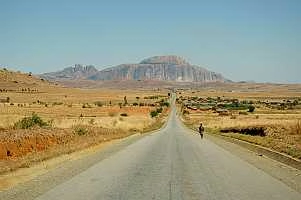The South including Isalo National Park: The arid south of Madagascar is noted for its many remarkable species of cactus and baobab-like plants.
Southern Highlands
 Fianarantsoa, a provincial capital, is an important center for wine and rice production and a good base for exploring the southern highlands. Places to visit in the surrounding mountains include Amabalavao, said to be the "home of the departed", where Antemora paper and lamba Aridrano silk are made; nearby Ambondrombe and Ifandana crags, where the revered bones of exhumed ancestors may be seen (the latter was the site of a mass suicide in 1811); Ambositra and the neighboring Zafimaniry villages, where intricate marquetry products are made; the Isalo National Park, situated in a chain of sandstone mountains (camping is possible but it can only be reached by 4-wheel-drive vehicles or on foot with a guide); it is also the gateway to the Ranomafana National Park, and to Pic Boby, the highest point in Madagascar.
Fianarantsoa, a provincial capital, is an important center for wine and rice production and a good base for exploring the southern highlands. Places to visit in the surrounding mountains include Amabalavao, said to be the "home of the departed", where Antemora paper and lamba Aridrano silk are made; nearby Ambondrombe and Ifandana crags, where the revered bones of exhumed ancestors may be seen (the latter was the site of a mass suicide in 1811); Ambositra and the neighboring Zafimaniry villages, where intricate marquetry products are made; the Isalo National Park, situated in a chain of sandstone mountains (camping is possible but it can only be reached by 4-wheel-drive vehicles or on foot with a guide); it is also the gateway to the Ranomafana National Park, and to Pic Boby, the highest point in Madagascar.
 Fianarantsoa, a provincial capital, is an important center for wine and rice production and a good base for exploring the southern highlands. Places to visit in the surrounding mountains include Amabalavao, said to be the "home of the departed", where Antemora paper and lamba Aridrano silk are made; nearby Ambondrombe and Ifandana crags, where the revered bones of exhumed ancestors may be seen (the latter was the site of a mass suicide in 1811); Ambositra and the neighboring Zafimaniry villages, where intricate marquetry products are made; the Isalo National Park, situated in a chain of sandstone mountains (camping is possible but it can only be reached by 4-wheel-drive vehicles or on foot with a guide); it is also the gateway to the Ranomafana National Park, and to Pic Boby, the highest point in Madagascar.
Fianarantsoa, a provincial capital, is an important center for wine and rice production and a good base for exploring the southern highlands. Places to visit in the surrounding mountains include Amabalavao, said to be the "home of the departed", where Antemora paper and lamba Aridrano silk are made; nearby Ambondrombe and Ifandana crags, where the revered bones of exhumed ancestors may be seen (the latter was the site of a mass suicide in 1811); Ambositra and the neighboring Zafimaniry villages, where intricate marquetry products are made; the Isalo National Park, situated in a chain of sandstone mountains (camping is possible but it can only be reached by 4-wheel-drive vehicles or on foot with a guide); it is also the gateway to the Ranomafana National Park, and to Pic Boby, the highest point in Madagascar.The East Coast
Mananjary is a popular beach resort on the east coast (but not for sea-bathing because of sharks).
Taolanaro (formerly Fort Dauphin), in the southeast corner of the island, has a backdrop of green mountains flowing into the blue sea. The city and surrounding area are famous for seafood, orchids and carnivorous pitcher plants. Fort Dauphin is the lobster capital of Madagascar.
The Southwest
Western Madagascar was once covered with deciduous forests, but is now mostly savannah. The economy is based around the zebu, a species of ox introduced in the eighth century by settlers from South-East Asia.
Western Madagascar was once covered with deciduous forests, but is now mostly savannah. The economy is based around the zebu, a species of ox introduced in the eighth century by settlers from South-East Asia.
Toliara, a provincial capital on the southwest coast, has excellent bathing beaches and opportunities for skin-diving, fishing, sailing and other water-sports.
